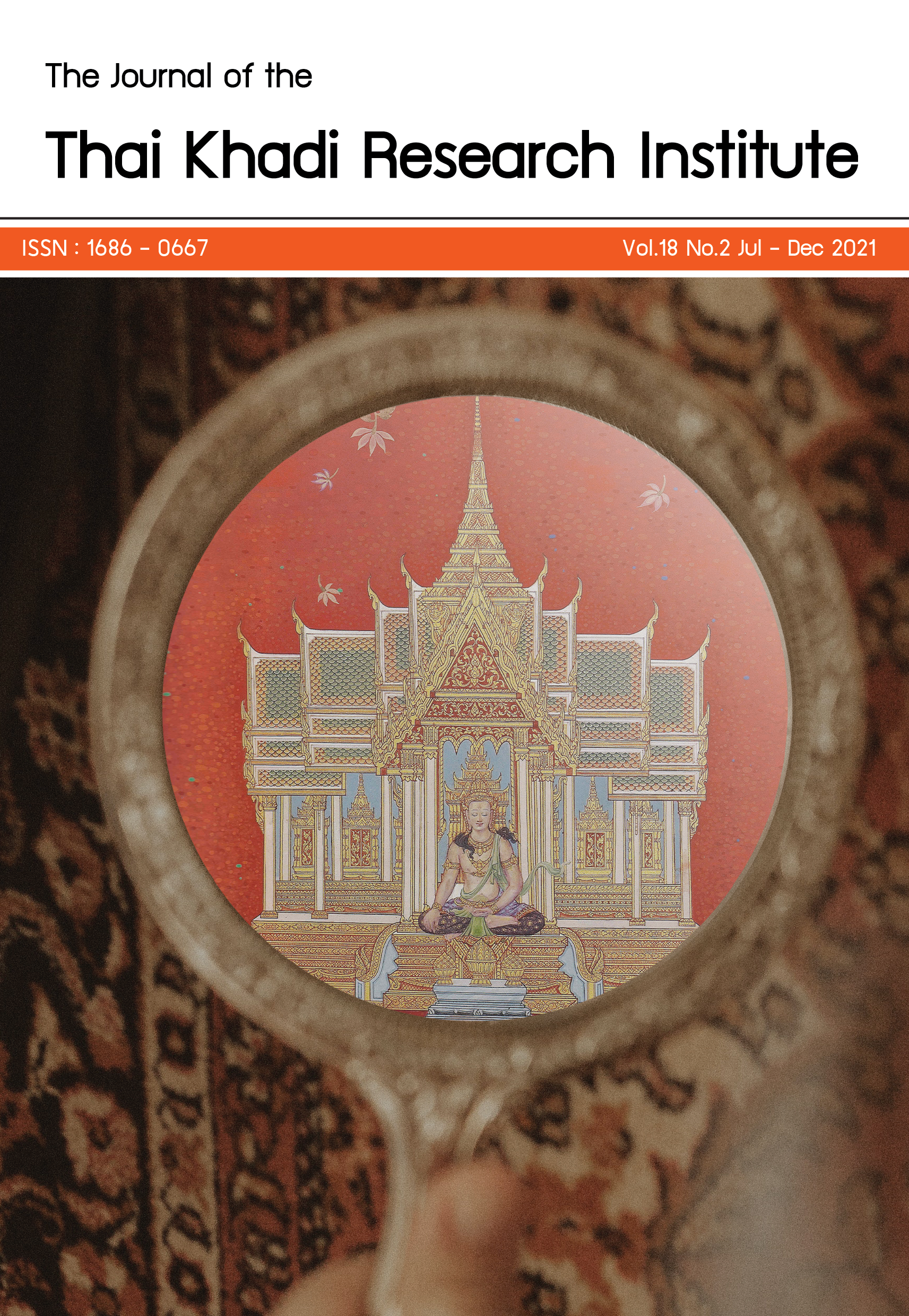ปีขึ้นครองราชย์ของพระเจ้าชัยวรมันที่ 7: ความสัมพันธ์กับการตีความภูตสังขยา ความเชื่อพระเวท และบริบทการเมือง
Main Article Content
บทคัดย่อ
บทความนี้ ต้องการชี้ให้เห็นว่าปีขึ้นครองราชย์ของพระเจ้าชัยวรมันที่ 7 ในจารึกกลุ่มอโรคยศาลา และจารึกปราสาทพิมานอากาศ ประกอบด้วยคำศัพท์ ภูตสังขยา คือ พระเวท - ท้องฟ้า - เลขหนึ่ง - พระจันทร์ ปัญหาคือ คำศัพท์ “พระเวท” ไม่น่าจะแทนเลข 3 หากแทนเลข 4 สอดคล้องกับแบบแผนภูตสังขยา และความเชื่อพระเวทในรัชสมัยพระเจ้าชัยวรมันที่ 7 ดังจารึกปราสาทโตว์ กล่าวถึงคัมภีร์พระเวททั้ง 4 ซึ่งเป็นคู่มือพราหมณ์ และจารึกปราสาทจรุง กล่าวถึงคัมภีร์ประเภทสมฤติ คู่มือเสริมคำอธิบายคัมภีร์พระเวทซึ่งเกิดขึ้นหลังจากที่พระเวท มี 4 เล่มแล้ว ดังนั้น ปีขึ้นครองราชย์ของพระเจ้าชัยวรมันที่ 7 จึงตรงกับ ม.ศ. 1104 (พระเวท = 4 ท้องฟ้า = 0 เลขหนึ่ง = 1 พระจันทร์ = 1) หรือ ค.ศ. 1182 (พ.ศ. 1725)
ผลการศึกษาชี้ให้เห็นว่า คำศัพท์ภูตสังขยา “ดวงตา” ในจารึกปราสาทมังคลารถ ไม่น่าจะแทนเลข 3 คือ แทนพระเนตร 3 ดวงของพระศิวะ ซึ่งหลุยส์ ฟิโนต์ อ้างว่าเป็นตัวเลขแทนพระเวท ในที่นี้ ผู้วิจัยจึงเสนอการตีความ 3 แนวทาง ดังนี้ แนวทางแรก ดวงตาไม่ได้แทนเลข 3 แต่แทนเลข 4 ตามคติความเชื่อของชาวอินเดียโบราณที่มองว่าพราหมณ์มองเห็นพระเวททั้ง 4 ได้ นัยนี้ ตาของพราหมณ์จึงมี 4 ตา แนวทางที่สอง การบันทึกปีขึ้นครองราชย์ของพระเจ้าชัยวรมันที่ 7 ในจารึกปราสาทมังคลารถคลาดเคลื่อนจากข้อเท็จจริง แนวทางที่สาม อาจมีระบบการนับตัวเลขหรือสัญลักษณ์ทางศิลปกรรมที่เชื่อมโยงกับดวงตา ซึ่งอาจจะมีการค้นพบในอนาคตก็เป็นได้
มีข้อสังเกตด้วยว่า ม.ศ. 1104 ปรากฏในจารึกหมีเซิน เป็นปีที่เจ้าชายวิทยานันทะเสด็จมายังอาณาจักรกัมพูชา แสดงว่าเจ้าชายจามน่าจะร่วมเฉลิมฉลองพระบรมราชาภิเษกของพระเจ้าชัยวรมันที่ 7 ในครั้งนั้นด้วย
Downloads
Article Details
ผู้เขียนจะต้องลงนามในแบบฟอร์มรับรองบทความ เพื่อให้คำยืนยันความรับผิดชอบว่า บทความของผู้เขียนนั้นไม่เคยตีพิมพ์ที่ใดมาก่อน พร้อมรับทราบว่า กระบวนการส่งบทความเข้าพิจารณาและตีพิมพ์ในวารสารไทยคดีศึกษานั้น จะไม่มีการเรียกเก็บค่าใช้จ่ายในการดำเนินการ ยกเว้น ในกรณีที่ผู้เขียนขอยกเลิกการตีพิมพ์บทความในวารสารไทยคดีศึกษาไม่ว่าด้วยสาเหตุใด และหลังจากบทความนั้นเข้าสู่กระบวนการพิจารณาของผู้ทรงคุณวุฒิไปแล้ว ผู้เขียนจะต้องรับผิดชอบต่อค่าใช้จ่ายที่เกิดขึ้นในกระบวนการประเมินเป็นจำนวนเงิน 3,000 บาท (สามพันบาทถ้วน)
เอกสารอ้างอิง
Barth, A. (1903). Les doublets de la stèle de Say - fong. BEFEO, III, 460 - 466.
Bhattacharya, K. (ed.). (2009). A selection of Sanskrit inscriptions from Cambodia. Siem Reap: Center for Khmer Studies.
Briggs, L.P. (1951). The ancient Khmer Empire. Philadelphia: The American Philosophical Society.
Bühler, G. (1962). Indian Paleography. Calcutta: Indian Studies, Past & Present.
Buravas, S. (1973). Pradchayaphrāmnaisamaiphutthakān [The Hindu philosophy]. Bangkok: Praepittaya.
Diskul, S, M.C. (2004). Sātsanāphrāmnaiʻānāčhakkhō̜m (Phim khrang thī 3) [Les Religions Brahmaniques dana I’Ancien Cambodge d’après l’Épigraphie et l’Iconographie]. Bangkok: Amarin Printing and Publishing PCL.
Chalorwong, C. et al. (2016). Cambodia Rātchaʻānāčhakkamphūchā. [Cambodia]. Chiang Mai: GMSS CMU.
Chandler, D. (2008). A History of Cambodia (4th ed.). Chiang Mai: Silkworm Books.
Chitsuthiyan, A. and others. (2012). Kānsưksāwičhaiklumjaruekprāsāttāmư̄an [A study Prasat Ta Muen Inscriptions]. Bangkok: Department of Oriental Languages, Silpakorn University.
Cœdès, G. (1937). Inscriptions du Cambodge voI.I. Hanoi: Imprimerie d’extreme - orient.
Cœdès, G. (1937). Inscriptions du Cambodge voI.III. Paris, E. de Boccard.
Cœdès, G. (1937). Inscriptions du Cambodge voI.V. Paris, Editions de Boccard.
Cœdès, G. (1941). La stèle du Práh Khằn d’Ankor. BEFEO, XLI, 255 - 302.
Cœdès, G. (1942). Inscriptions du Cambodge voI.II. Hanoi: Imprimerie d’extreme - orient.
Cœdès, G. (1968). The Indianized States of Southeast Asia. Honolulu: East West Center Press.
Cœdès, G. (1974). Pour - mieux comprendre Angkor. Paris: librairie d'Amerique et d'orient Adrien Maisonneuve.
Finot, L. (1903). L’inscription sanskrite de Say - fong: II. L’inscription sanskrite de Say - Kong. BEFEO, III, 18 - 33.
Finot, L. (1904). Notes d’épigraphie: XI. Les inscriptions de Mi - Sơn. BEFEO, IV, 897 - 977.
Finot, L. (1925). Inscriptions d’Angkor. Honoi: Imprimarie d’Extrême - Orient.
Hall, D.G.E. (1955). A History of Southeast Asia. London: Macmillan.
Harris, I. (2005). Cambodian Buddhism: History and Practice. Honolulu: University Hawai’i Press.
Jacques, C. (1970). Études d’épigraphie cambodgienne. VI. Sur les données chronologiques de la stèle de Tûol Ta Pec (k.834). BEFEO, LVIII, 163 - 176.
Jacques, C. (2007). The Historical development of khmer culture from the death of Sūryavarman II to the 16th century. Bayon: New perspectives. Bangkok: River Book.
Jacques C. & Goodall, D. (2017). Stèle inscrite d’Īśānavarman II à Vat Phu (k.1320). Aséanie, 33, (juin 2014). Bangkok: Sirindhorn Anthropology Centre.
Kamandalu, S.W. (2014). The Seven Sacred Rivers of Hinduism. London: Mayur University.
Kam - Ek, B. (2004). sam nō thēwī ‘athapphawēt kap khwām chư̄a thāng wēt mon khō̜ng Khon Thai [Athar Veda with the magic beliefs of Thai people.]. Damrong Journal, 3(5), 222 - 235.
Khamtho, A. (1886). jaruekmư̄angsēmā [Muang Sema Inscription]. The Inscriptions in Thailand volume 3: Khom Script, 15th - 16th Buddhist century. Bangkok: The National Library of Thailand.
Maxwell, Thomas S. (2007). The Stele Inscription of Preah Khan, Angkor. Journal of Khmer Studies UDAYA, 8, 1- 113.
Maxwell, Thomas S. (2007). A New Khmer and Sanskrit Inscription at Banteay Chmar. Journal of Khmer Studies UDAYA, 10, 135 - 201.
Phronsuthirak, M. (1999). Botsadudeenaijaruekphāsāsansakritkhō̜ng kamphūchā [Praśasti in the Sanskrit inscriptions of Cambodia]. In Phāsā - jaruek Chabapthī 6: Khurubūchā Khururamlưk. [Phāsā - čhārưk: chabap 6 Khurubūchā khururamlưk] (281 - 301). Bangkok: Department of Oriental Languages, Silpakorn University.
Phronsuthirak, M. (2008). Prawatwannakhadīsansakrit [History of Sanskrit literature]. Nakhon Pathom: Silpakorn University Printing House.
Radhakrishnan, S. (1948). Indian Philosophy Volume - I. London: George Allen & Unwin.
Ramasubramanian, K. & Sriram, M. S. (2011). Tantrasaṅgraha of Nīlakaṇṭha Somayājī. London: Springer Science & Business Media.
Sarma, S. R. (2019). A Descriptive Catalogue of Indian Astronomical Instruments: Abridged Version. Hamburg: Tradition GmbH.
Sarapadnuke, C. (1979). Wannakamphrawēt [Vedic literature]. Bangkok: Department of Oriental Languages, Silpakorn University.
Sharan, M. K. (1981). Select Cambodian inscriptions: The Mebon and Pre Rup inscriptions of Rajendra Varman II. Delhi: s.n.
Sharrock, P. D. (2009). Garuḍa, Vajrapāṇi and religious change in Jayavarman VII's Angkor. Journal of Southeast Asian Studies, 40(1), 111 - 151.
Shastri, Satya Vrat. (2014). Sanskrit Inscriptions of Thailand. Delhi: Vikas Computer & Printers Naveen Shahdara.
Thamrungraeng, R. & Pakdeekham, S. (2014). Sinlapakhamēn [Cambodian art]. Bangkok: Matichon.
Veda Vyasa. (2013, September 16).Mahābhārata Udyoga Parva Adhyāya 34. Retrieved April 26, 2020, from https://sans kritdocuments.org/mirrors/mahabharata/unic/mbh05_sa. html.
Vickery, M. (2006). Bayon: New Perspectives Reconsidered. Journal of Khmer Studies UDAYA, 7, 101 - 173.
Warrier, S. (2014). Kamandalu: The Seven Sacred Rivers of Hinduism. London: Mayur University.
Wongthet, P. (2013). Mư̄angphranakhǭn nakornwat nakornthom [Angkor: An Introduction]. Bangkok: Dream catcher.
Woodward, H. (2007). Foreword in Bayon: New perspectives. Bangkok: River Book.
Yamdate, N. (2015). Kānsưksājaruekprāsāttāphō̜nmakhō̜ngphra čhaochaiwō̜ramanthī Čhet [A Study of Alaṃkāra in the Ta - Prohm Inscription of Jayavarman VII] (Master’s thesis, Silpakorn University).
Interviewee Prapandvidya, C. Silpakorn University, Bangkok Province. 13 January 2020.


